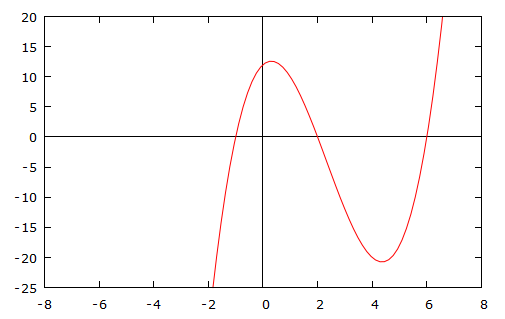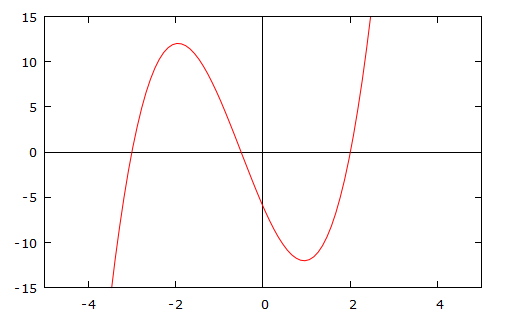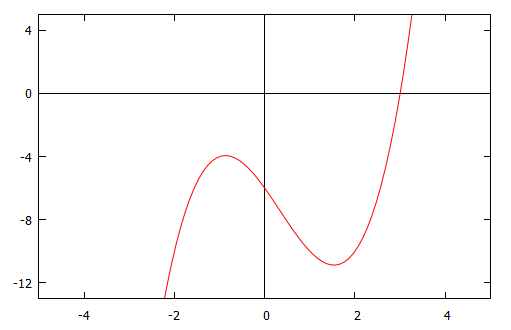Solving Cubic Equations
Cubic Equations
A cubic equation is an equation of the form \[ax^3+bx^2+cx+d = 0\]
By the Fundamental Theorem of Algebra, a cubic equation has either one or three real-valued solutions, or roots.
There is a formula to explicitly find the roots of any cubic equation, similar to the quadratic formula, but it's considerably more complicated. However, it is sometimes possible to find a solution by trial and error, or inspection. If one is found then we can immediately write down a linear factor of the cubic expression and use polynomial division to obtain an equation of the form $(ax+b)(x^2+cx+d) = 0$. Solving the quadratic equation $x^2+fx+g=0$ will then give the last two roots (if they exist).
Worked Examples
Example 1
Find all the roots of $x^3-7x^2+4x+12=0$.
Solution
Use trial and error to find the first root:
- $x=1$: $(1)^3-7(1)^2+4(1)+12 = 1-7+4+12 = 10 \neq 0 $
\[x=2 \Rightarrow (2)^3-7(2)^2+4(2)+12 = 8-28+8+12= 0\]
So $x=2$ is a root.
Divide the cubic by $x-2$.
\begin{align} x-2&\overline{\big)x^3\!-7x^2\!+4x\!+\!12} \end{align}
\begin{align} &\;\: x^2\\ x-2&\overline{\big)x^3\!-7x^2\!+4x\!+\!12}\\ &\;\: x^3-2x^2\\ \end{align}
\begin{align} &\;\: x^2\\ x-2&\overline{\big)x^3\!-7x^2\!+4x\!+\!12}\\ &\;\: x^3-2x^2\\ &\;\:\overline{0 -5x^2+4x+12} \end{align}
\begin{align} &\;\: x^2-5x\\ x-2&\overline{\big)x^3\!-7x^2\!+4x\!+\!12}\\ &\;\: x^3-2x^2\\ &\;\:\overline{0 -5x^2+4x+12}\\ &\quad\;\; -5x^2+10x \end{align}
\begin{align} &\;\: x^2-5x\\ x-2&\overline{\big)x^3\!-7x^2\!+4x\!+\!12}\\ &\;\: x^3-2x^2\\ &\;\:\overline{0 -5x^2+4x+12}\\ &\quad\;\; -5x^2+10x\\ &\qquad \overline{\; 0\:-\:6x\:+\:12} \end{align}
\begin{align} &\;\: x^2-5x-6\\ x-2&\overline{\big)x^3\!-7x^2\!+4x\!+\!12}\\ &\;\: x^3-2x^2\\ &\;\:\overline{0 -5x^2+4x+12}\\ &\quad\;\; -5x^2+10x\\ &\qquad \overline{\; 0\:-\:6x\:+\:12}\\ &\qquad \quad \; -\:6x \;+\;12\\ &\qquad \qquad \qquad \quad \; \overline{\;0} \end{align}
We have already shown that $x=2$ was a root of the cubic equation, so now we must solve $x^2-5x-6=0$ to get the remaining two roots.
By factorising, we have \[x^2 - 5x -6 = (x-6)(x+1)\]
$x=6$ and $x=-1$ are roots of the quadratic, and hence of the cubic equation also.
Therefore, the roots of this cubic are
\[x_1=2, \; x_2=6, \; x_3=-1\]
Here is the graph of $f(x)=x^3-7x^2+4x+12$.

As you can see, it crosses the axis three times, at the points $x=2$, $x=6$ and $x=-1$.
Example 2
Find all the roots of $2x^3+3x^2-11x-6=0$.
Solution
Use trial and error to find the first root:
\[x = 1 \Rightarrow 2(1)^3+3(1)^2-11(1)-6 = 2+3-11-6 = -12 \neq 0\]
\[x=2 \Rightarrow 2(2)^3+3(2)^2-11(2)-6 = 16+12-22-6= 0\]
So $x=2$ is a root.
Use the polynomial factorisation method to pull out a factor of $x-2$:
\[2x^3+3x^2-11x-6 = 2x^2(x-2)+7x(x-2)+3(x-2) = (x-2)(2x^2 + 7x + 3)\]
Now solve the quadratic $2x^2+7x+3=0$ to find the last two roots.
Using the quadratic formula:
\begin{align} x &= \frac{-7 \pm \sqrt{7^2-(4\times2\times3)} }{2\times2}\\ &=\frac{-7 \pm \sqrt{49 - 24} }{4}\\ &=\frac{-7 \pm \sqrt{25} }{4}\\ &=\frac{-7 \pm 5}{4} \end{align}
So $x= \dfrac{-7-5}{4} = -3 \; \text{ or } \; x=\dfrac{-7+5}{4} = -\dfrac{1}{2}$
Therefore, the roots of this cubic are
\[x=2, \; x=-3, \; x= -\dfrac{1}{2}\]
Here is the graph of $f(x)=2x^3+3x^2-11x-6$.

As you can see, it crosses the axis three times, at the points where $x=2$, $x=3$ and $x=-\dfrac{1}{2}$.
Example 3
Find all the roots of $x^3-x^2-4x-6=0$.
Solution
Use trial and error to find the first root:
\[x = 1 \Rightarrow (1)^3-(1)^2-4(1)-6 = 1-1-4-6 = -10 \neq 0\]
\[x = 2 \Rightarrow (2)^3-(2)^2-4(2)-6 = 8-4-8-6= -10 \neq 0\]
\[x = 3 \Rightarrow (3)^3-(3)^2-4(3)-6 = 27-9-12-6= 0\]
So $x=3$ is a root.
Divide the cubic by $(x-3)$:
\[x^3-x^2-4x-6 = x^2(x-3)+2x(x-3)+2(x-3) = (x-3)(x^2 + 2x + 2)\]
The roots of the quadratic $x^2+2x+2$ yield the remaining two roots of the cubic.
We will start by finding the discriminant of the quadratic to see if it has real roots.
We have the values $a=1$, $b=2$ and $c=2$, so the discriminant is \[b^2-4ac = 2^2-(4\times 1\times 2) = 4-8 = -4.\]
The discriminant is negative, so the quadratic has no real roots.
Therefore, this cubic only has one real root, $x=3$.
Here is the graph of $f(x)=x^3-x^2-4x-6$.

As you can see, it crosses the $x$-axis only once, at the point $x=3$.
Video Examples
Example 1
Prof. Robin Johnson finds all the roots of the equation $x^3-2x^2-21x-26=0$ using the factorisation method of polynomial division.
Example 2
Prof. Robin Johnson finds all the roots of the equation $6x^3+x^2-13x-3=0$ using the long division method of polynomial division.
Workbook
This workbook produced by HELM is a good revision aid, containing key points for revision and many worked examples.
External Resources
- Cubic equations workbook at mathcentre.